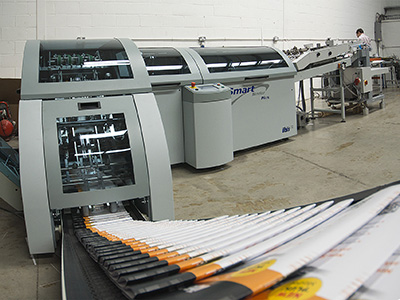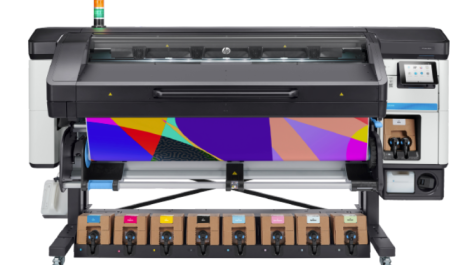Smart-binder PLUS is the latest generation of IBIS Integrated Bindery System’s UK-built high end digital finishing system.
The Smart-binder system series can be configured in a variety of booklet and book finishing options for producing short job runs, or personalised ‘books-of-one’ (including variable thicknesses on the fly), either in-line with a continuous digital press, or offline from a roll or a sheet pile feeder. About 60% of installed systems run inline. A standout feature is the ability to produce both wire-stitched and cold glued booklets or signatures on the same machine.
IBIS is a successful exporter, with only 10% of sales in the UK. It was founded in the late 1990s by engineers who had originally worked with the once-famous finishing manufacturer Harris in Slough (this had been taken over in turn by AM and then Heidelberg before they left). They saw an emerging requirement for finishing machines to work with digital presses. Originally almost all of IBIS’ machines were sold via Océ to run with its Variostream digital web press lines.
Today the company occupies a factory unit in a business park near High Wycombe, where it has its office with CAD based design facilities, a demonstration bay for one or more finishing machines, plus a store for commonly needed parts. Manufacture of the machines is contracted to Vacuumatic’s factory in Colchester.
The original Smart-binder was introduced at drupa 2004. That was a development of Digi-stitcher DS2, the company’s first product in 1999. Smart-binders are offered in five standard configurations, depending on customers’ needs and budgets. All are customisable to the point that managing director John Cracknell says that probably no two are exactly the same. ‘We claim to be able to do anything and don’t like to say no to anyone,’ he explains. ‘It’s what we’re known for – a very flexible solution. We don’t just offer a box off the shelf.’
The latest PLUS versions were introduced at drupa in May. They offer higher input web speeds for inline running, four-page increments, increased cycling rate, improved book transport with a faster trimmer, a much higher capacity cover feeder (with improved reliability), automatic stop-stitch, and optional selective folding. Maximum input width is 464 mm.
IBIS developed a gravity assisted collector for the trimmer. This is angled downward and self-adjusts to variable book thicknesses. Conventional trimmers are horizontal and need belts that have to be adjusted for variable thicknesses.
The new F-200 selective folder option can switch between an eight-page and 12-page sheet fold on the fly. This allows speeds up to 600 feet per minute, producing booklets in four-page increments.
Individual sheet gluing (ISG) on the Smart-binder and PLUS is a patented process that’s unique to IBIS. It puts dots of PVA adhesive on the fold line to create glued sections up to 8 or 10 mm thick without wire stitching. Cold glue costs about the same as wire, but advantages include greater strength, flat-lying books and easier recycling. ‘This was an engineering idea, not market driven, but it has been very well received by our customers!’ says Mr Cracknell. ‘It creates flatter and stronger booklets compared with wire.’
Smart-binders could be suppled with ISG only, but no customers have asked for it so far.
Two of the standard configurations don’t include gluing. The SB-1 is a reduced speed, entry-level saddle stitcher for use inline with cut-sheet printers at up to 400 A4 pages per minute. All the others are for web presses and run at up to 2000 pages per minute, equivalent to up to 7000 booklets per hour (1-up), or 14,000 per hour (2-up).
The higher speed SB-2 for web presses, is also wire stitching only. The other Smart-binders, SB-3, SB-4 and SB-5, all combine the option of saddle stitching and ISG gluing. SB-3 is the standard configuration and SB-4 adds an IBIS-modified single-clamp perfect binder inline with the saddle-binder. SB-5 includes an in-line perfect binder which is separate from the saddle-binder.
The SB-4 and SB-5 offer saddle-bound (stitched or cold-glued) booklets and perfect-bound books as part of a single, in-line continuous web system. They can output up to 7000 saddle-stitched booklets per hour or up to 1500 perfect bound books per hour (one up).
Because Smart-binder SB-4 PLUS now handles increments of four pages, there will never be more than three blanks at the end of perfect bound books. Conventional perfect binders often handle signatures containing eight or more page increments, so there could be seven or more blanks at the end.
The Sprint-binder 600C single-clamp perfect binder offered with the SB-4 is a modified CP Bourg BB3002, outputting 400 books per hour. ‘Normally you drop sections from above the clamp and at speed they may bounce,’ says Mr Cracknell. ‘We designed a system to push them in sideways so there’s no bounce. We call this the SCF, or Sheet Collector Feeder. If we feed it with signatures made on the Smart Binder that have already been cold glued inside, there’s no need to mill off the spine. The result looks like it’s been thread sewn. The hot and cold melted glued combination is also very strong. Only about a dozen people use this though, so it’s not widely known yet.’
Seeing a demand for a four clamp binder, the company has now developed the Sprint-binder 2000, which can produce up to 1500 books per hour with a choice of EVA or PUR gluing.
Smart-binders have integral bar code tracking for data integrity, which is particularly important for insurance proposals or financial statements, but also for one-off books in general,where the cover has to match the block. For inline configurations a signal is sent to the press to trigger an immediate reprint after a reject. If it’s running offline it generates a record that’s used to request replacement copies as a later press run.
The demo Smart-binder PLUS unit that was in the showroom when we visited is an SB-3 configuration with ISG and wire stitching, running offline, with a pile feeder. This is in the main photograph above.
Pricing depends on the wide choice of specification, but as a guide an SB-2 (wire only) without cover feeder would cost around £120,000. An SB-3 (wire and ISG) without cover feeder would be about £144,000. A cover feeder is around £11,000.
The 100th Smart-binder has recently been supplied to a printer in Boston, USA, that will produce over a million booklets a month. IBIS is confident of increased sales in future as high-end digital web printing continues to expand.
Contact: www.ibis-bindery.com





